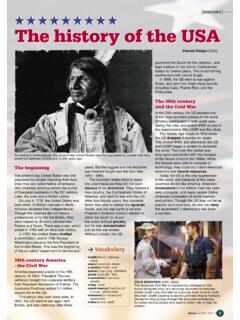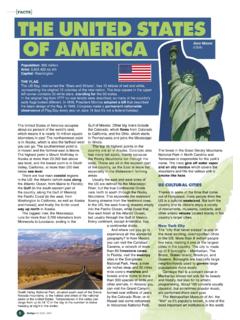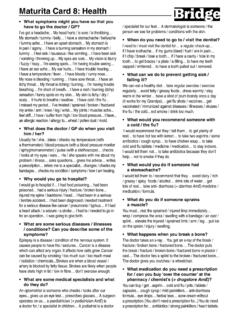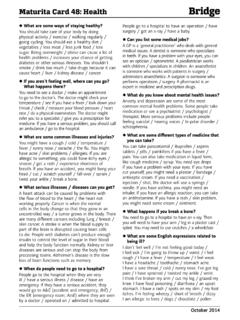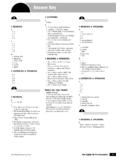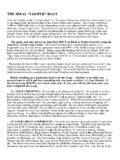Transcription of 8 geography Behind the maple leaf - Bridge-online.cz
1 Bridge 06 2008/2009 The name Canada comes from the ancient Iroquois Indian word kanata , which means village , or settlement . However, the country Canada has grown into something much larger than that. Canada is the second largest country in the world by area (Russia is the largest). But many people who visit Canada are still struck by the small-town feeling they get. Perhaps this is because Canada, despite its size, has a population of only 33 million people. A significant reason for this low number is the fact that a lot of the Canadian terrain is rough and uninhabitable and the climate is arctic in the north. A large percentage of Canadians live in cities along the Canada US border. The three largest urban centres: Toronto ( million people), Montr al (4 million people), and Vancouver ( million people) are very ethnically diverse.
2 The United Nations has actually ranked Toronto as the most multicultural city in the world. Despite this, many of the country s original inhabitants, the Native Indian populations, live segregated and in very poor conditions in reservations. The Inuits (Eskimos) inhabits the northern territories of Canada. Canada s capital city, Ottawa, only has a population of about 1 million. History of Canadian settlementThe beaver is the national animal of Canada because beavers were so abundant in Canada that the French decided to send permanent settlers in the 1500s. Clothing made of beaver fur was very popular in France back then. When the French landed in Canada and discovered a new wilderness full of beavers, they saw a good business opportunity and created the first permanent settlement in present day Qu bec the American Revolution and the signing of the Declaration of Independence from Britain in 1776, many British settlers in America who were loyal to Britain fled the new United States to resettle further north in Canada.
3 Eventually a confederation of Canadian provinces was established in 1867 and Canada gained independence from Britain with the status of a sysTem The Canadian government was modeled directly on the British parliamentary system. Like in Britain there are two chambers: the House of Commons (for passing laws) and the Senate (for a secondary vote to pass laws). The British monarch is still the official head of state and all laws passed by the Canadian government must be ratified by the reigning monarch (currently Queen Elizabeth II). Instead of ratifying every law personally, the British monarch is represented by the Governor General. The Governor General is appointed by the elected prime minister of Canada, so the British royal family has very little influence on Canadian government today.
4 In 1982, Prime Minister Pierre Elliott Trudeau s government drafted and passed the first ever Canadian constitution. This document, which was signed by Queen Elizabeth II in Ottawa, was the first document which enabled full political independence for Canada from administrationCanada is politically divided into 10 provinces and three territories:the maritimesThe four provinces on the Atlantic are Newfoundland, Nova Scotia, Prince Edward Island (the smallest of the Canadian provinces), and New Brunswick. There is still rich Scottish and Irish heritage in these provinces, which can be clearly seen in the geography8 Behind the maple leaftHings you migHt not know about CanadaThese Innuit children have built a stone figure. Such structures have many functions: they serve for giving directions or marking a special place.
5 The Inuit tradition forbids their destruction. The Canadian Rocky Mountains, AlbertaBridge 06 2008/20099annual summer bagpipe and fiddle festivals and competitions. Alexander Graham Bell, inventor of the telephone, lived in Nova Scotia for some time, and his home is now a museum in his honour. Though the entire country of Canada is considered bilingual, New Brunswick is the only province that is officially frenchman s provinceMoving west, Qu bec is the country s largest province by area, and is officially Canada s only French speaking province. Many visitors say that Qu bec City and Montr al are the most European feeling cities in Canada. There have been political movements in Qu bec over the past 50 years trying to separate the province from the rest of Canada. They often reference the Czechoslovakian separation agreement of 1993 as a old upper Canada Further west, Ontario is the original British province, with many towns recalling the mother country, such as London and Stanford.
6 Ontario has two sides. Southern Ontario has the highest concentration of urban population in the entire country; elsewhere the rest of this rather large province is mainly agricultural and wilderness. The cities of southern Ontario outside of Toronto are primarily industrial and manufacturing centres. The area surrounding the western end of Ontario Lake has been nicknamed The Golden Horseshoe because of its shape; there has been a lot of development in this area. In the very south of Ontario, on the border with New York state, you can visit one of the wonders of the world, Niagara Falls. As well as being one of the great tourist destinations in Canada, Niagara Falls is a major producer of hydro electricity for the PrairiesThe three prairie provinces lying west of Ontario are Manitoba, Saskatchewan, and Alberta.
7 These provinces produce most of the wheat and other grains in Canada, thanks to the flat surface and rich soil there. Alberta is where the prairies end and the Rocky Mountains begin. Alberta, as well as having favourable farming conditions, is also rich in oil deposits (which is why Edmonton s NHL team is called the Oilers ). Calgary, Alberta was home to the 1988 Winter Olympic games, and is just a few hours away from beautiful Banff, a popular tourist destination in the Rocky Mountains. Alberta is also well known in the paleontology world for its deposits of dinosaur fossils. There is even a dinosaur, Albertosaurus, named after the Pacific CanadaBritish Columbia is the westernmost province in Canada, sitting on the Pacific coast. It is physically divided from the rest of Canada by the great Rocky Mountains, and many British Columbians claim to feel a psychological alienation too.
8 Its largest city, Vancouver, will be home to the 2010 Winter Olympic far northThe three territories that occupy the north of Canada are the least inhabited areas. The Yukon Territory, Northwest Territories, and Nunavut, consist mainly of ice and tundra, and the permafrost on the ground makes agriculture, building, and development nearly impossible. Yet it is an ideal environment for whales, wolves, and dogsledding races. The largest city in all of the territories is Whitehorse, Yukon, with a population of 21,000 people. Jeff Gulley (Canada)Vocabularymaple leaf ["meIp(@)l li;f] - javorov listare struck by the small town feeling they get [strVk] - nab vaj pocitu, e jsou na malom st rough [rVf] - tvrd uninhabitable [VnIn"habIt@b(@)l] - neobyvateln ethnically diverse ["ETnIklI daI"v@;s] - etnicky rozmanit the United Nations has ranked [r&Nkd] - Organizace spojen ch n rod ohodnotilasettlement - os dlen beaver ["bi;v@] - bobrabundant [@"bVnd(@)nt] - hojn fur [f@;] - ko e inawilderness ["wIld@nIs] - divo inato flee (fled) - uprchnoutpassing laws - schvalov n z kon to ratify ["r&tIfaI] - schv lit, ratifikovatreigning [reInIN] - vl dnouc to draft - vypracovatconstitution [kQnstI"tju.]
9 S(@)n] - stavabagpipes ["b&gpaIpz] - dudyfiddle ["fId(@)l] - houslein his honour ["Qn@] - na jeho po estto reference ["rEf(@)r(@)ns] - odkazovathorseshoe - podkovawheat and other grains [wi;t greInz] - p enice a jin obilninyrich soil [sOIl] - rodn p daoil deposits [dI"pQzIts] - z soby ropypsychological alienation [saIk@"lQdZIk(@)l eIlI@"neIS(@)n] - psychologick odcizen dogsledding races [slEdIN] - z vody ps ch sp e en glossarydominion - a self-governing territory which accepts the British Monarch as Head of State Governor General - the representative of the British Crownpermafrost - permanently frozen ground in Arctic regionslanguage pointSpelled with a capital letter, Arctic refers to the regions around the Nor th Pole. Spelled with a lower case ( arctic ), it means extremely Labrador and New Foundland2.
10 Prince Edward Island3. Nova Scotia4. New Brunswick5. Q u e b e c6. Ontario 7. Manitoba 8. Saskatchewan 9. Alberta 1 0 . British Columbia 1 1 . Yukon Territory 1 2 . Northwest Territory13. Nunavutmap of canadaOttawa skaters using the Rideau Canal as an ice Port of Montreal on the St. Lawrence River is the largest inland port in the world.
